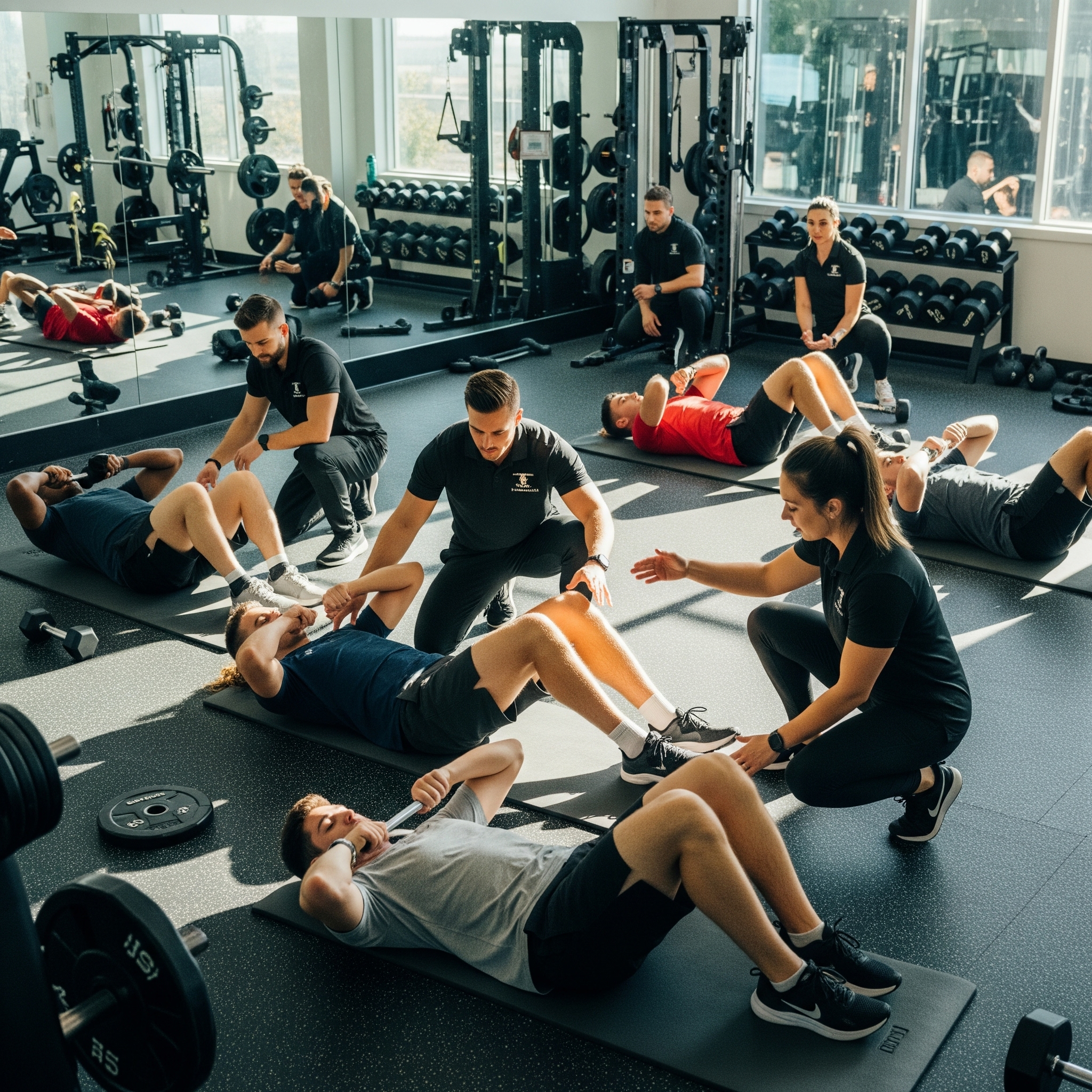Small Group, Big Results: Your Path to Fitness Success

Small Group, Big Results: Your Path to Fitness Success
Embarking on a fitness journey can often feel overwhelming.
With so many options available – from solo workouts to large group classes and one-on-one personal training – finding the right fit for your goals, budget, and personality is crucial.
One increasingly popular and highly effective option that strikes a perfect balance is small group training.
This dynamic approach offers the best of both worlds, providing individualized attention within a supportive and motivating group environment.
What is Small Group Training and How Does it Differ from Other Fitness Options?

Small group training involves a certified personal trainer working with a limited number of participants, typically between two and eight individuals.
Unlike general group exercise classes, which often follow a one-size-fits-all format, small group training allows for more personalized coaching, modifications, and direct feedback from the instructor.
The small size enables the trainer to focus on each participant’s form, progress, and specific needs, ensuring a safer and more effective workout experience.
Small Group Training vs. One-on-One Personal Training
While one-on-one personal training offers the highest degree of individualized attention, it often comes with a higher price tag. In contrast, small group training provides many of the benefits of personalized coaching at a more accessible cost.
With a one-on-one session, the trainer’s entire focus is on you, allowing for highly tailored programs that address every nuance of your fitness goals, limitations, and preferences.
This can be invaluable for those with specific injuries, advanced goals, or who simply prefer exclusive attention.
However, small group training bridges the gap by allowing you to share the cost of a highly qualified trainer’s expertise with a few other motivated individuals.
While the program might be designed for the group as a whole, the small participant count means the trainer can still offer significant individual correction and encouragement.
You won’t get lost in the crowd, and your trainer can still identify and address your unique needs, adjusting exercises as necessary.
This hybrid model provides a fantastic middle ground for those seeking professional guidance without the full financial commitment of one-on-one sessions.
It’s a great way to benefit from expert advice on proper form, progressive overload, and effective exercise selection, ensuring you make the most of your time in the gym.
Small Group Training vs. Large Group Fitness Classes
Large group fitness classes, such as Zumba, spin, or general aerobics, are known for their high energy, social atmosphere, and affordability.
They are excellent for boosting motivation and making exercise fun. However, due to the large number of participants, individualized attention is minimal.
Trainers may not be able to closely monitor everyone’s form, leading to a higher risk of improper technique or injury, especially for beginners or those with specific physical limitations.
The workouts are typically designed for a general audience, offering less scope for customization to individual fitness levels or goals.
Small group training, conversely, offers a more intimate and attentive setting. While still benefiting from the motivating energy of a group, participants receive closer supervision and feedback from the trainer.
This allows for exercises to be modified up or down based on individual fitness levels, health conditions, or injuries.
For example, if someone has knee issues, the trainer can provide alternative exercises or modify the intensity to ensure they still get an effective workout without discomfort.
This adaptability is a key differentiator, making small group training a safer and more results-driven option than many large group classes, while still fostering a sense of community and shared effort.
What are the Benefits of Small Group Training?

Small group training offers a compelling array of benefits that contribute to both physical results and a more enjoyable fitness journey.
From financial advantages to psychological boosts, this training style is gaining popularity for good reason.
Cost-Effectiveness
One of the most appealing aspects of small group training is its affordability compared to one-on-one personal training.
When you train individually, you bear the full cost of the trainer’s time and expertise. In a small group setting, the cost is distributed among all participants, significantly reducing the per-person expense.
This makes high-quality, professional coaching accessible to a broader range of individuals who might otherwise find personal training financially prohibitive.
You receive many of the benefits of personalized attention at a fraction of the price, making consistent, guided fitness a sustainable part of your lifestyle.
This economical approach allows for longer-term adherence to a fitness program, leading to better and more lasting results.
Enhanced Motivation and Accountability
Working out with others can be a powerful motivator. In a small group setting, you’re not just accountable to your trainer, but also to your fellow group members.
Knowing that others are expecting you can significantly boost your commitment and consistency.
The shared experience creates a built-in support system; you’ll push each other to work harder, celebrate successes together, and provide encouragement when someone is struggling.
This sense of camaraderie fosters a positive and energetic atmosphere that can make workouts more enjoyable and less likely to be skipped.
Research suggests that social support and friendly competition within a group can lead to greater effort and higher adherence rates compared to solitary workouts.
This mutual encouragement can be particularly beneficial on days when your individual motivation might be lacking.
Personalized Attention and Improved Form
Despite being a group setting, the “small” in small group training is key. With fewer participants, trainers can dedicate more time to observing each individual, correcting form, and ensuring exercises are performed safely and effectively.
This personalized feedback is crucial for preventing injuries and maximizing the effectiveness of each movement.
Unlike large classes where errors might go unnoticed, a small group trainer can quickly identify and address improper technique, guiding you to perform exercises correctly.
This attention to detail means you’re learning proper mechanics, which translates to better results and a deeper understanding of your body.
It ensures that the exercises you perform are truly beneficial for your unique physique and goals, optimizing your effort and minimizing risk.
For those at Delta Valley Health Club looking for specialized guidance, programs like MX4 Training often utilize small group dynamics to deliver tailored, results-driven workouts.
Workout Variety and Customization
Small group training sessions often incorporate a diverse range of exercises and modalities, keeping workouts fresh, challenging, and engaging.
Trainers can introduce various equipment, from free weights and resistance bands to cardio machines and functional training tools, preventing boredom and ensuring a well-rounded fitness routine.
The ability to customize exercises within the group means that while everyone is working towards a common goal, the intensity and specific movements can be adapted to individual fitness levels, health conditions, or even personal preferences.
This flexibility ensures that you are consistently challenged appropriately without being overworked or under-stimulated, making each session productive and enjoyable.
It also exposes you to different types of training you might not try on your own, broadening your fitness horizons and continuously challenging your body in new ways.
Social Connection and Community
Beyond the physical benefits, small group training fosters a strong sense of community. Working out alongside others who share similar fitness aspirations creates opportunities for new friendships and a supportive network.
This social aspect can transform exercise from a chore into an enjoyable social activity. The shared journey, triumphs, and challenges build bonds that extend beyond the gym walls.
This sense of belonging can significantly enhance overall well-being, providing emotional support and a deeper connection to your fitness routine.
It turns your workout partners into teammates, creating an environment where everyone cheers each other on and celebrates collective progress.
Is Small Group Training Worth the Money?

Given the array of benefits, small group training is undoubtedly a worthwhile investment for many individuals.
When evaluating its value, consider the blend of personalized attention, motivational support, and cost-effectiveness it offers.
For those who find one-on-one personal training too expensive but desire more guidance than a large group class provides, small group training is an ideal solution.
You receive expert coaching, a structured workout plan, accountability, and the positive energy of a group, all at a more budget-friendly price point.
The consistent guidance on form and technique alone can save you from potential injuries and wasted effort that might occur in self-directed or large group settings.
Moreover, the increased motivation and accountability often lead to higher adherence rates, meaning you’re more likely to stick with your fitness routine and achieve your goals.
This long-term commitment translates into tangible results – improved strength, endurance, body composition, and overall health.
When weighing the cost, consider the return on investment in terms of sustained health, confidence, and a more effective and enjoyable fitness journey.
Many find that the unique balance offered by small group training provides exceptional value, making it a smart and effective choice for their fitness needs.
How to Find a Small Group Training Program That Fits Your Budget

Finding the right small group training program involves more than just looking at the price tag; it’s about finding a program that aligns with your financial comfort while delivering on quality and results.
Here are some strategies to help you find a program that’s both effective and affordable:
Research Local Gyms and Studios
Start by exploring fitness centers in your area. Many gyms, like Delta Valley Health Club, offer various small group training programs.
Visit their websites or call to inquire about their specific offerings, class sizes, schedules, and pricing structures.
Look for introductory offers or package deals, as these can often provide significant savings. When considering a facility like Delta Valley, investigate their small group training options, as they often tailor programs to diverse fitness levels and goals.
Understand Pricing Models
Small group training costs can vary based on location, trainer experience, session length, and frequency.
Some facilities offer monthly memberships that include a certain number of small group sessions, while others might charge per session or per package of sessions.
Compare these models to see which best fits your anticipated usage and budget.
Don’t hesitate to ask about payment plans or discounts for committing to longer periods.
Inquire About Group Size
While “small group” implies limited numbers, the exact size can vary (e.g., 3-5 vs. 6-8 participants).
Generally, smaller groups might offer slightly more individualized attention but could also be a bit more expensive per person. Understand the typical group size to gauge the level of personalized interaction you can expect.
Look for Trial Sessions or Free Consultations
Many gyms and trainers offer complimentary trial sessions or consultations.
his is an excellent opportunity to experience the training style firsthand, meet the trainer, and see if the group dynamic is a good fit for you before committing financially.
It also allows you to ask detailed questions about the program and discuss your personal fitness goals.
Consider Online or Hybrid Options
In today’s digital age, some trainers offer online small group training, which might be more budget-friendly due to lower overhead costs for the trainer.
Hybrid models combine in-person sessions with online support or programming, offering flexibility and potentially lower overall costs.
Communicate Your Budget
Don’t be afraid to be upfront about your budget with potential trainers or gym staff.
They might be able to suggest alternative programs, less frequent sessions, or different package options that align with your financial constraints. A good fitness provider will work with you to find a viable solution.
By thoroughly researching your options and being clear about your needs, you can find a high-quality small group training program that helps you achieve your fitness goals without breaking the bank.
Conclusion
Small group training stands out as a highly effective and increasingly popular fitness solution, perfectly blending the individualized attention of personal training with the motivating and cost-effective dynamics of a group setting.
It offers a unique environment where expert guidance, personalized modifications, and a strong sense of community converge to foster significant physical gains and sustained motivation.
From providing a more affordable alternative to one-on-one coaching to enhancing accountability and offering diverse, customized workouts, the benefits are clear.
Participants not only improve their physical fitness but also build valuable social connections, making their fitness journey more enjoyable and sustainable.
Whether you’re looking to overcome a plateau, learn proper form, stay motivated, or simply enjoy working out with like-minded individuals, small group training provides a compelling pathway to achieving your health and wellness aspirations.
It’s an investment in your well-being that delivers tangible results and a supportive community, proving its worth for anyone committed to their fitness journey.
